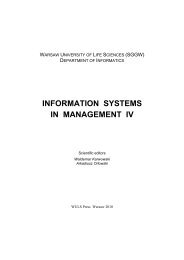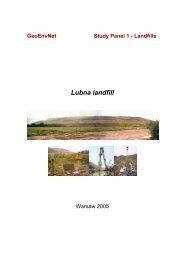ACTA SCIENTIARUM POLONORUM - SGGW
ACTA SCIENTIARUM POLONORUM - SGGW
ACTA SCIENTIARUM POLONORUM - SGGW
You also want an ePaper? Increase the reach of your titles
YUMPU automatically turns print PDFs into web optimized ePapers that Google loves.
64 L. Mazal, K.J. RowlesTHE TIME SERIES OF DATAThe time series of the GDPs and indices of industrial production were collected formOECD database. The GDP series consist of quarterly values and the series of index ofindustrial production accounts for monthly values. The longest possible data ranges weredeployed. The Table 1 provides data ranges. In case of all time series, logarithms havebeen taken so that they were used in logarithmic form during all computations. All computationshave been conducted by using MATLAB programming environment.Table 1. Data rangesTabela 1. Zakres danychCountryGDPNumberof ObservationsIndex of IndustrialProductionNumberof ObservationsCzechRepublicQ1 1996 – Q3 2007 47 January 1989 – November 2007 215Slovakia Q1 1995 – Q4 2007 52 January 1990 – December 2007 228Poland Q1 1995 – Q4 2007 52 January 1985 – December 2007 277Hungary Q1 1995 – Q4 2007 52 January 1985 – January 2008 276Source: OECD Stats Extracts.Źródło: OECD Stats Extracts.AUGMENTED DICKEY-FULLER TESTWhen estimating a polynomial trend in logarithms of GDP and index of industrialproduction series, the autocorrelation functions of regression residuals have a slowly decayingpattern and oscillate around zero. This pattern suggests unit root [Enders 2004].However, a more exact methodology is applied to the series. The Dickey-Fuller [1979]developed a test to investigate the presence of the unit root. This test is applied to fourcountries of the former Soviet bloc; Czech Republic, Slovakia, Poland and Hungary. Theintention is to demonstrate whether their outputs and indices of industrial production confirmlaissez faire policy or active economic interventions. As testing statistics, it has beendecided to use the Augmented Dickey-Fuller test [Dickey and Fuller 1979].It will be tested if the parameter a 1 is greater than one in absolute value in the equation4.yt= a0 + a1⋅ yt− 1+ a2⋅ t + b1⋅ Δyt−1+ b2⋅ Δyt−2+ ... + bn⋅ Δyt−k+ εt[4]The term b1 ⋅ Δyt−1+ b2⋅ Δyt−2+ ... + bn⋅ Δyt−krefers to the lags for corrections of residualautocorrelation. It is worth pointing out that too many lags lead to a loss of degreesof freedom and reduce the power of the test to reject the null of the unit root.The lag length k is selected using the t-statistics, which is in line with Perron [1994]who argues that the methods based on information criteria are less appropriate. Thismethod sets the number of lagged variables so that the lagged variables are included upto the last statistically significant lagged variable.In line with Dickey and Fuller [1979], the equations have been transformed by subtractingyt–1 from each side so that the model has the following final form:Acta Sci. Pol.
















